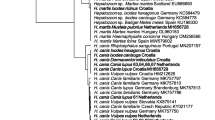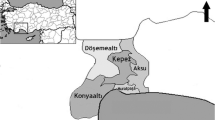Abstract
Hepatozoon canis is a common protozoan of dogs, being among the most prevalent tick-borne pathogens infecting dogs around the world. It is primarily transmitted by Rhipicephalus sanguineus, the brown dog tick. In this study we tested ticks collected from dogs and from the environment in order to track the origin of an outbreak of H. canis infection detected in October 2009 in a private dog shelter in southern Italy. Ticks from dogs (n = 267) were collected during the spring of 2009, whereas ticks from environment (n = 300) were found on sticky traps placed in the same shelter during the summer of 2009. All ticks were tested by PCR for the detection of a H. canis 18S ribosomal RNA gene fragment. Four (1.5%, one female and three males) ticks collected from dogs were PCR positive. None of the larvae collected from the environment were positive, but a relatively high infection rate (8.0%) was detected in nymphs. These findings point out that dogs became infected during the summer, when ticks were abundant and highly infected by H. canis. Moreover, this study suggests that castor oil sticky traps might be useful to collect engorged immature ticks in highly infested environments (e.g., dog shelters). This might be particularly interesting to evaluate the level of infection by certain pathogens in free-ranging ticks R. sanguineus, as done in the present study.
Similar content being viewed by others
References
Altschul SF, Madden TL, Schäffer AA, Zhang J, Zhang Z, Miller W, Lipman DJ (1997) Gapped BLAST and PSI-BLAST: a new generation of protein database search programs. Nucleic Acids Res 25:3389–3402
Ayres M, Ayres M Jr, Ayres DL, Santos AS (2007) Biostat 5.0: Aplicações Estatísticas Nas Áreas das Ciências Biológicas e Médicas. Sociedade Civil Mamirauá–Belém, MCT-CNPq, Brasília, 364 pp
Baneth G, Samish M, Shkap V (2007) Life cycle of Hepatozoon canis (Apicomplexa: Adeleorina: Hepatozoidae) in the tick Rhipicephalus sanguineus and domestic dog (Canis familiaris). J Parasitol 93:283–299
Dantas-Torres F (2008) Canine vector-borne diseases in Brazil. Parasit Vectors 1:25
Dantas-Torres F (2010) Biology and ecology of the brown dog tick, Rhipicephalus sanguineus. Parasit Vectors 3:26
Dantas-Torres F, Otranto D (2011) Rhipicephalus sanguineus on dogs: relationships between attachment sites and tick developmental stages. Exp Appl Acarol 53:389–389
Forlano M, Scofield A, Elisei C, Fernandes KR, Ewing SA, Massard CL (2005) Diagnosis of Hepatozoon spp. in Amblyomma ovale and its experimental transmission in domestic dogs in Brazil. Vet Parasitol 134:1–7
Gabrielli S, Kumlien S, Calderini P, Brozzi A, Iori A, Cancrini G (2010) The first report of Hepatozoon canis identified in Vulpes vulpes and ticks from Italy. Vector Borne Zoonotic Dis 10:855–859
Götsch S, Leschnik M, Duscher G, Burgstaller JP, Wille-Piazzai W, Joachim A (2009) Ticks and haemoparasites of dogs from Praia, Cape Verde. Vet Parasitol 166:171–174
Inokuma H, Ohno K, Onishi T, Raoult D, Brouqui P (2001) Detection of ehrlichial infection by PCR in dogs from Yamaguchi and Okinawa Prefectures, Japan. J Vet Med Sci 63:815–817
Inokuma H, Okuda M, Ohno K, Shimoda K, Onishi T (2002) Analysis of the 18S rRNA gene sequence of a Hepatozoon detected in two Japanese dogs. Vet Parasitol 106:265–271
Lorusso V, Dantas-Torres F, Lia RP, Tarallo VD, Mencke N, Capelli G, Otranto D (2010) Seasonal dynamics of the brown dog tick, Rhipicephalus sanguineus, on a confined dog population in Italy. Med Vet Entomol 24:309–315
Miranda RL, de Castro JR, Olegário MM, Beletti ME, Mundim AV, O'Dwyer LH, Eyal O, Talmi-Frank D, Cury MC, Baneth G (2011) Oocysts of Hepatozoon canis in Rhipicephalus (Boophilus) microplus collected from a naturally infected dog. Vet Parasitol 17:392–396
Otranto D, Dantas-Torres F (2010) Canine and feline vector-borne diseases in Italy: current situation and perspectives. Parasit Vectors 3:2
Otranto D, de Caprariis D, Lia RP, Tarallo V, Lorusso V, Testini G, Dantas-Torres F, Latrofa S, Diniz PP, Mencke N, Maggi RG, Breitschwerdt E, Capelli G, Stanneck D (2010) Prevention of endemic canine vector-borne diseases using imidacloprid 10% and permethrin 50% in young dogs: a longitudinal field study. Vet Parasitol 172:323–332
Otranto D, Dantas-Torres F, Weigl S, Latrofa MS, Stanneck D, de Caprariis D, Capelli G, Baneth G (2011) Diagnosis of Hepatozoon canis in young dogs by cytology and PCR. Parasit Vectors 4:55
Reye AL, Hübschen JM, Sausy A, Muller CP (2010) Prevalence and seasonality of tick-borne pathogens in questing Ixodes ricinus ticks from Luxembourg. Appl Environ Microbiol 76:2923–2931
Rubini AS, Paduan KS, Martins TF, Labruna MB, O'Dwyer LH (2009) Acquisition and transmission of Hepatozoon canis (Apicomplexa: Hepatozoidae) by the tick Amblyomma ovale (Acari: Ixodidae). Vet Parasitol 164:324–327
Sangioni LA, Horta MC, Vianna MC, Gennari SM, Soares RM, Galvão MA, Schumaker TT, Ferreira F, Vidotto O, Labruna MB (2005) Rickettsial infection in animals and Brazilian spotted fever endemicity. Emerg Infect Dis 11:265–270
Solberg VB, Neidhardt K, Sardelis MR, Hildebrandt C, Hoffmann FJ, Boobar LR (1992) Quantitative evaluation of sampling methods for Ixodes dammini and Amblyomma americanum (Acari: Ixodidae). J Med Entomol 29:451–456
Tarallo VD, Dantas-Torres F, Lia RP, Otranto D (2010) Phlebotomine sand fly population dynamics in a leishmaniasis endemic peri-urban area in southern Italy. Acta Trop 116:227–234
Vojta L, Mrljak V, Curković S, Zivicnjak T, Marinculić A, Beck R (2009) Molecular epizootiology of canine hepatozoonosis in Croatia. Int J Parasitol 39:1129–1136
Walker JB, Keirans JE, Horak IG (2000) The genus Rhipicephalus (Acari, Ixodidae): a guide to the brown ticks of the world. Cambridge University Press, Cambridge
Acknowledgments
Thanks to Bayer Animal Health GmbH for partially support this research.
Author information
Authors and Affiliations
Corresponding authors
Rights and permissions
About this article
Cite this article
Dantas-Torres, F., Latrofa, M.S., Weigl, S. et al. Hepatozoon canis infection in ticks during spring and summer in Italy. Parasitol Res 110, 695–698 (2012). https://doi.org/10.1007/s00436-011-2544-8
Received:
Accepted:
Published:
Issue Date:
DOI: https://doi.org/10.1007/s00436-011-2544-8




